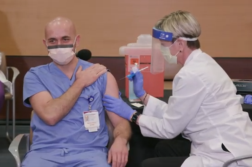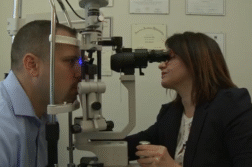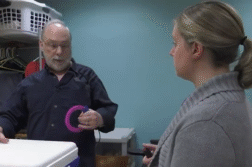SAN DIEGO, Calif. (Ivanhoe Newswire) – More than three million Americans suffer from epilepsy. Not knowing when or if a seizure will strike can make living life difficult. Most people can take medications to control it. But up to 30 percent of people who have epilepsy don’t respond to drug therapy. Now, for the first time, a new experimental cell therapy is aimed at eliminating seizures without medication or invasive brain surgery.
They can strike anytime, anywhere! Now, a new clinical trial for epilepsy is using a regenerative brain cell procedure to stop seizures.
“Our goal, there, is to, actually, achieve seizure freedom,” says Neurosurgeon at UC San Diego Health, Sharona Ben-Haim, MD.
Standard epilepsy treatment begins with medications, then removal of the parts of the brain causing the seizures. But there is a risk of damaging healthy brain tissue. Now, doctors at UC San Diego are using MRI guidance to pinpoint the exact area causing the seizures, then, cells derived from stem cells are injected.
“This therapy offers us the opportunity to not destroy tissue, but to, actually, rehabilitate it and recover it,” explains Neurologist and Director of the Comprehensive Epilepsy Center at UC San Diego Health, Jerry Shih, MD.
The first patient they treated was a 38-year-old man who had five to eight seizures a month. Two months after the procedure, his seizures decreased.
“He’s had better than a 95% reduction in his seizures, which is tremendous,” says Dr. Shih.
Doctors hope as time goes by, he may even become seizure-free. The very first patient to have regenerative cell therapy in New York experienced 30 seizures a month and now, a year after treatment, is seizure-free. Both patients are part of a national clinical trial. Patients who participate must have temporal lobe epilepsy and will be monitored regularly for two years after the procedure.
Contributors to this news report include: Marsha Lewis, Producer; Matt Goldschmidt, Videographer; Roque Correa, Editor.
To receive a free weekly e-mail on medical breakthroughs from Ivanhoe, sign up at: http://www.ivanhoe.com/ftk
Source:
https://www.cdc.gov/epilepsy/about/fast-facts.htm
MEDICAL BREAKTHROUGHS
RESEARCH SUMMARY
TITLE: TRAINING BRAIN CELLS TO STOP EPILEPTIC SEIZURES
REPORT: MB #5395
BACKGROUND: Epilepsy, also known as a seizure disorder, is a brain condition that affects the brain, leading to recurring seizures. There are various types of epilepsy, and while the cause can be identified in some people, in others, it remains unknown. According to the Centers for Disease Control and Prevention, it’s estimated that 1.2% of people in the United States have active epilepsy. Epilepsy can affect anyone regardless of gender, race, ethnic background, or age. Seizure symptoms can differ widely, ranging from loss of awareness to blank staring, convulsions, and twitching of arms or legs. It’s important to note that having a single seizure doesn’t necessarily mean epilepsy.
(Source: https://www.mayoclinic.org/diseases-conditions/epilepsy/symptoms-causes/syc-20350093)
DIAGNOSING: If you experience two or more seizures that weren’t caused by a known medical condition for example, from alcohol withdrawal or low blood sugar you’re considered to have epilepsy. Before making a diagnosis, your healthcare provider will perform a physical exam, take your medical history and may order blood work to rule out other causes. They may ask about your symptoms during the seizure and conduct other tests, as well. Electroencephalography (EEG) test measures the electrical activity in your brain. Certain abnormal electrical patterns are related to seizures. Brain scans: Magnetic resonance imaging (MRI) to look for such things as tumors, infections or blood vessel abnormalities.
(Source: https://my.clevelandclinic.org/health/diseases/17636-epilepsy#symptoms-and-causes)
NEW TREATMENT: UC San Diego Health’s multidisciplinary team performed the third ever experimental regenerative brain cell therapy procedure earlier this month. Sharona Ben-Haim, MD, associate professor of neurological surgery at University of California San Diego School of Medicine and surgical director of epilepsy at UC San Diego Health, made multiple injections of inhibitory brain cells into mapped out precision points of the patient’s brain under the bright lights of the operating room. The cells, called interneurons, are derived from human stem cells. “This experimental cell therapy implants healthy human brain cells into the damaged temporal lobe with the hope that those new cells will begin establishing connections in the patient’s brain, to ultimately make a healthier temporal lobe.” said Jerry Shih, MD, professor of neurosciences at UC San Diego School of Medicine, neurologist and director of the Epilepsy Center at UC San Diego Health. This new experimental regenerative therapy could potentially treat multiple parts of the brain without tissue removal, offering new hope to drug-resistant epilepsy patients.
FOR MORE INFORMATION ON THIS REPORT, PLEASE CONTACT:
Jeanna Vazquez
If this story or any other Ivanhoe story has impacted your life or prompted you or someone you know to seek or change treatments, please let us know by contacting Marjorie Bekaert Thomas at mthomas@ivanhoe.com




